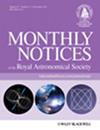FREDDA dedispersion 算法对使用 FRB 进行 H0 估计的影响
IF 4.7
3区 物理与天体物理
Q1 ASTRONOMY & ASTROPHYSICS
引用次数: 0
摘要
快速射电暴(FRBs)是源于银河系外的瞬时射电信号,会受到色散和散射等传播效应的影响。因此,这些信号蕴含着它们所穿越的介质的信息,因此可以作为宇宙学的探测器来探测宇宙。最近,FRB 被用来对哈勃常数 H0 进行独立测量,只要探测到足够数量的 FRB,就有望解决哈勃张力问题。这种宇宙学研究依赖于 FRB 的数量统计、宇宙学参数和探测偏差,因此准确描述这些参数的特征非常重要。在这项工作中,我们根据经验确定了澳大利亚平方公里阵列探路者(ASKAP)当前探测系统--快速实时振幅再分散引擎(FREDDA)的灵敏度。我们对 13 个 ASKAP 检测到的 FRB 的高时间分辨率数据进行了相干再分散,并将其注入 FREDDA,以确定恢复的信噪比与分散度(DM)的函数关系。我们发现,对于 13 个 FRB 中的 11 个,这些结果与注入理想化脉冲是一致的。当 H0 是唯一的自由参数时,用理论预测来近似这个灵敏度函数,会产生 0.3 km s-1 Mpc-1 的系统误差。如果允许其他参数变化,系统误差可能会增加 1 km s-1 Mpc-1。我们估计,在探测到 400 ∼ 400 个局部 FRB 之前,这种系统性不会有什么影响,但在解析哈勃张力时可能会有很大影响。本文章由计算机程序翻译,如有差异,请以英文原文为准。
The impact of the FREDDA dedispersion algorithm on H0 estimations with FRBs
Fast radio bursts (FRBs) are transient radio signals of extragalactic origins that are subjected to propagation effects such as dispersion and scattering. It follows then that these signals hold information regarding the medium they have traversed and are hence useful as cosmological probes of the Universe. Recently, FRBs were used to make an independent measure of the Hubble Constant H0, promising to resolve the Hubble tension given a sufficient number of detected FRBs. Such cosmological studies are dependent on FRB population statistics, cosmological parameters and detection biases, and thus it is important to accurately characterise each of these. In this work, we empirically characterise the sensitivity of the Fast Real-time Engine for Dedispersing Amplitudes (FREDDA) which is the current detection system for the Australian Square Kilometer Array Pathfinder (ASKAP). We coherently redisperse high-time resolution data of 13 ASKAP-detected FRBs and inject them into FREDDA to determine the recovered signal-to-noise ratios as a function of dispersion measure (DM). We find that for 11 of the 13 FRBs, these results are consistent with injecting idealised pulses. Approximating this sensitivity function with theoretical predictions results in a systematic error of 0.3 km s−1 Mpc−1 on H0 when it is the only free parameter. Allowing additional parameters to vary could increase this systematic by up to ∼1 km s−1 Mpc−1. We estimate that this systematic will not be relevant until ∼400 localised FRBs have been detected, but will likely be significant in resolving the Hubble tension.
求助全文
通过发布文献求助,成功后即可免费获取论文全文。
去求助
来源期刊

Monthly Notices of the Royal Astronomical Society
ASTRONOMY & ASTROPHYSICS-
CiteScore
9.10
自引率
37.50%
发文量
3198
审稿时长
3 months
期刊介绍:
Monthly Notices of the Royal Astronomical Society is one of the world''s leading primary research journals in astronomy and astrophysics, as well as one of the longest established. It publishes the results of original research in positional and dynamical astronomy, astrophysics, radio astronomy, cosmology, space research and the design of astronomical instruments.
 求助内容:
求助内容: 应助结果提醒方式:
应助结果提醒方式:


